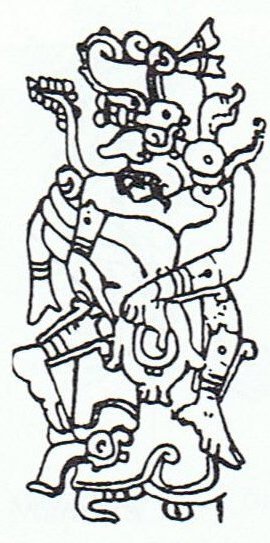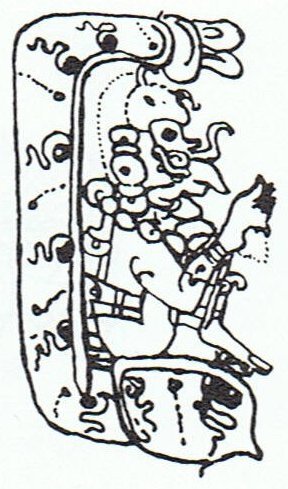|
TRANSLATIONS
Next page with underpages:
|
A discovery made
in our preliminary survey of the beginning of the back side of R is that we probably should -
at least sometimes - begin to count the ordinal number of a
glyph from the last glyph of side b instead of from the first
one on side a, in which case rona in Ra2-9 would be number 40
and rona in Rb8-5 be at position 405:
|
39 |
 |
187 |
177 |
 |
|
Ra2-9
(40) |
364 |
Rb8-5 (405) |
Moreover, we can
be fairly sure that 364 glyphs in between indeed should be
interpreted as 364 days. The main argument for this is based on reading
a 'marriage' between Sun and Moon at
midsummer in the following 4-glyph sequence:
|
Rakau (the Tree) |
 |
 |
 |
 |
|
*Rb1-17
(244) |
Rb2-1 |
Rb2-2 |
Rb2-3 |
|
17
Opata roa a mana aia. |
18 vai tara kai u(a) a
ngao
roaroa a
ngao
tokotokoa. |
19 hia uka a hakairiiri a
hakaturuturu. |
20 hanga ohiro a pakipaki renga. |
Ordinal number 244
is probably here the result of adding 64 to 180. Furthermore, the
important Hanga Ohiro I have allocated to Rb2-3, where
its ordinal number
247 can easily be understood as pointing to the product of Sun (24) and Moon
(7) - the everpresent 168 - and this 'in turn' ought to help us to define where
the triplet of rona glyphs at the beginning of line Rb8
belongs:
|
246 |
 |
153 |
|
Rb2-3
(247) |
|
400 |
 |
 |
 |
|
Rb8-1 |
Rb8-2 |
Rb8-3 |
 |
 |
 |
 |
|
Rb8-4 (404) |
Rb8-5 |
Rb8-6 |
Rb8-7 |
 |
 |
 |
 |
|
Rb8-8 |
Rb8-9 |
Rb8-10 |
Rb8-11 |
 |
 |
 |
 |
|
Rb8-12 |
Rb8-13 (413) |
Rb8-14 |
Rb8-15 |
Tagata kai
in Rb8-15 obviously refers to spring, and its position must be beyond
winter solstice. The open mouth is announced already in maitaki
(Rb8-1).
Hau tea in
Rb8-13 has a single great mata in front and its position is
14 * 29.5 = 413 (Tama). By comparing with G it is evident
that R cannot have Rogo in position 409, instead there are 2
'turtles' with fins in Rb8-8 and Rb8-11 (where 8 * 11 also is 88):
 |
 |
 |
 |
 |
 |
 |
|
Gb6-26
(409) |
Gb6-27 |
Gb6-28 |
Gb7-1 |
Gb7-2
(413) |
Gb7-3 |
Gb7-4 |
In G the Rogo
figure probably defines winter solstice, but in R winter solstice
could be located in the last glyph line on
side b, an odd line where hardly any glyphs are visible.
Manu kake in
Rb8-3 probably stands at a cardinal point, and another manu kake
has been located at position 264:
 |
 |
 |
 |
... |
... |
|
Rb2-19 |
Rb2-20
(264) |
Rb2-21 |
Rb2-22 |
*Rb2-23 |
*Rb2-24 |
If glyph number
264 marks day 264, then we should be able to add 100 to reach the end of the
year, and the glyphs seem to agree:
 |
99 |
 |
 |
 |
|
Rb2-20
(264) |
Rb6-30 (364) |
Rb6-31 |
Rb6-32 |
| 6
* 30 = 180 |
6 * 32 = 192 |
However, there are
4 + 4 = 8 feather signs at right in Rb6-30, which probably refers to
Moon (not to Sun). 192 / 29.5 = 6½ + ¼. Therefore we have at least two
alternatives to read Rb6-32, e.g. either as 365½ - 365 or as 192 - 191¾.
In both cases a complete glyph should not be drawn here.
A season of Moon
(however it should be understood in detail) is ending at the
beginning of line Rb8, and 2 of the rona glyphs are
presumably to be read as a pair, with waxing first and waning
following, maybe these:
The first in
the triplet, we can guess, could then refer to rona
in Ra2-9:
 |
187 |
174 |
 |
|
Ra2-9
(40) |
361 |
Rb8-2
(402) |
But the numbers seem to tell us this alternative is wrong: 361 (or
362) carries no great weight. Maybe, instead, the Sun rona
is
Rb8-7:
 |
187 |
179 |
 |
|
Ra2-9 |
366 |
Rb8-7 |
Rb8-7 is glyph number 180 on side b and it is also drawn without
a full perimeter - it is not a true 'person' but only a rona. I
have erased 40 respectively 407 (the ordinal numbers of these
rona glyphs) because their ordinal numbers are not certain. If the
total number of glyphs are to be counted as 451, then we can
count 451 - 367 = 84 as a possible number for Ra2-9.
It is all very
uncertain. 361 maybe should be understood as 9 * 29 + 100?
|
|
Much earlier and on
the other side of the earth there once was a marriage between Sun
and Earth at midsummer:
...
Then
I
become
aware
of
...
a
presence
- a
faint,
ghostly
glimmering,
like
moonglow,
that
has
appeared
on
the
solstice
stone.
I
don't
know
how
long
it
lasts,
a
second
or
two
only
I
would
guess,
but
while
it
is
there
it
seems
less
like
a
projection
-
which
I
know
it
to
be -
than
something
immanent
within
the
stone
itself.
And
it
seems
to
function
as a
herald
for
it
fades
almost
as
soon
as
it
has
appeared
and
in
its
place
the
full
effect
snaps
on -
instantaneously.
It
wasn't
there,
and
then
it's
there.
As
Chris
had
described,
the
effect
does
curiously
resemble
a
poleaxe,
or a
flag
on a
pole,
and
consists
of a
'shaft',
narrow
at
the
base
but
widening
a
little
towards
the
top,
running
up
the
left
hand
side
of
the
solstice
stone,
surmounted
by a
right-facing
'head'
or
'flag'.
An
instant
later
an
almond-shaped
spot
of
light,
like
an
eye,
appears
a
few
centimeters
to
the
right
of
the
'flag'
and
the
effect
is
complete.
Weirdly
- I
do
not
claim
it
has
any
significance
-
this
flag-on-a-pole
symbol
is
the
ancient
Egyptian
hieroglyph
neter,
meaning
'god',
or
'a
god'
-
and
not
to
be
understood
at
all
in
the
Judaeo-Christian
usage
of
that
word
but
rather
as a
reference
to
one
of
the
supernatural
powers
or
principles
that
guide
and
balance
the
universe.
Manifested
here,
in
this
strange
Stone
Age
temple,
it
glows,
as
though
lit
by
inner
fire.'
This
was
at
Mnajdra
on
Malta
(cfr
at
hahe).
Marija
Gimbutas:
'To sleep within the Goddess's womb was to die and to
come to life anew'.
In a system of
reincarnation the old one must die in order to be reborn, of course.
At midsummer Sun comes to a standstill, and this must therefore be the
occasion when the 'flame of life' had to be transposed into a new
body.
The station immediately beyond 'climbing the tree' is a station
inside the earth:

 |
|
(420 - 4) / 16 =
26 is an equation which we could imagine is stating that the 'Tree'
has 4 glyphs and that for Sun (26) time stands still during these 4
days:
|
Rakau (the Tree) |
 |
 |
 |
 |
|
*Rb1-17
(244) |
Rb2-1 |
Rb2-2 |
Rb2-3 |
|
17
Opata roa a mana aia. |
18 vai tara kai u(a) a
ngao
roaroa a
ngao
tokotokoa. |
19 hia uka a hakairiiri a
hakaturuturu. |
20 hanga ohiro a pakipaki renga. |
*Rb1-16 (243) would then be the last glyph (day)
counted before time stops, and we must
remember from G (cfr at honui):
 |
243 |
 |
63 |
|
Ga6-24 (165) |
Gb6-26 (409) |
|
244 = 4 * 61 |
64 = 4 * 16 |
243 and 244 are numbers which evidently are connected with the
solstices. 6-24 and 6-26 could, maybe, point to
the front side of the year (24) respectively to the
back side (26). But rather the other way around
because Rogo in Gb6-26 is probably the
first glyph of the new year. In R we have
provisionally reached 226 and 224 glyphs for the
front side respectively the back side of the
tablet.
At
rau hei we guessed that 243 (= 9 * 27 = 3 * 3 * 3
* 3 * 3) stood for the period of 'pregnancy'
before rebirth:
|
If Gb8-30 is counted only once: |
 |
226 |
 |
 |
242 |
|
Gb6-26 (408) |
Ga6-24 (164) |
Ga6-25 |
|
228 |
243 |
|
471 |
228
(= 12 * 19) from Rogo and winter solstice
at Gb6-26 up
to and including Ga6-24 equals the number of
glyphs on side a of G.
408
and 164 are better numbers than 409 and 165:
40 *
8 = 320 and 16 * 4 = 64 = 320 / 5.
40 *
9 = 360 and 16 * 5 = 80, but 360 is not a
multiple of 80. Furthermore 360 is a day which
belongs to the old year, it is not the first day
of the new year.
|
Counting 14 nights forward from Opata Roa
(17 or 4 + 17 = 21) we will arrive at
Rano Raraku - given that item 28 is
counted for 2:
|
Rakau
(the Tree) |
|
17 |
Opata roa a mana aia. |
|
18 |
vai tara kai u(a) a ngao roaroa
a ngao tokotokoa. |
|
19 |
hia uka a hakairiiri a
hakaturuturu. |
|
20 |
hanga ohiro a pakipaki renga. |
|
Waning Moon |
|
21 |
ko roto kahi a touo renga. |
|
22 |
ko papa kahi a roro. |
|
23 |
ko puna a tuki a hauhau renga |
|
24 |
ko ehu ko mahatua a piki rangi a
hakakihikihi mahina |
|
25 |
ko maunga teatea a pua katiki. |
|
26 |
ko te hakarava a hakanohonoho. |
|
New Moon |
|
27 |
ko hanga nui a te papa tata ika. |
|
28 |
ko tongariki a henga eha tunu
kioe hakaputiti.ai |
|
|
ka haka punenenene henua mo
opoopo o tau kioe |
|
29 |
ko te rano a raraku. |
The last 4 lines probably are to be counted
as the first of next month, which means
that number 26 (or with 4 added - the 30th
night) is
the last night of the current month.
Hanga Nui evidently is the first night of
the new month. Opata Roa is the
first night
beyond Waxing Moon and Hango Ohiro is
the last night to be counted.
Waning Moon is not 14 nights long,
only 6 nights long.
|
4 |
New Moon |
4 |
The Tree |
|
16 |
Waxing Moon |
6 |
Waning Moon |
|
20 |
nights to be counted |
10 |
nights not counted |
Maybe they crossed over items 30-31 in order
to underline that a month should end in
another way than the missionaries'
alternating 30 and 31 days:
30 |
ko oparingi a a uuri |
31 |
ko motu kumu koka a
kaoa |
|
The
picture is complex. 243 seems to carry more
weight than 244, but it is hard to decide which
of these numbers is embedded in the texts. An
example is offered by kara etahi in
Aa2-33 (cfr at vaero):
Ordinal number 123 becomes 243 if we add 120.
And then we can go on and add another 120 in
order to reach the day of Rogo (cfr at
maro):
|
|